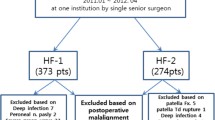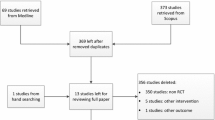Abstract
Purpose
The purpose of this prospective, randomised, double-blind study was to test the hypotheses that patients with high-flexion total knee arthroplasty (TKA) have (1) a wider/greater range of motion (ROM) post-operatively and (2) higher levels of knee society score (KSS) and WOMAC score post-operatively compared to standard TKA.
Methods
In this study, 28 high flexion with 31 standard TKAs were compared. We measured ROM, pre-operatively, on day 3, 7, 28, and after 6 and 36 months post-operatively as well as KSS and WOMAC score pre-operatively, on day 28 and after 6 and 36 months post-operatively.
Results
No statistically significant differences were found between both groups with regard to the target parameters. The mean ROM was 113° (range 80°–140°, SD 13.4°) in the control group (standard TKA) and 117° (range 90°–140°, SD 12.3) in the study group (high-flexion TKA) at 36 months follow-up [p = not significant (n.s.)]. The KSS pre-operatively was 38.2 (range 8–64, SD 15.8) in the control group and 45.9 (range 8–74, SD 16.0) in the study group (n.s.) increasing to 157.6 in the control group and 156.7 in the study group (p = n.s) at 36 months follow-up.
Conclusion
This study could not confirm significant benefits of high-flexion TKA compared to standard TKA with regard to ROM and higher levels of KSS and WOMAC score.
Level of evidence
I.



Similar content being viewed by others
References
Bajammal SS, Petruccelli D, Adili A, Winemaker M, de Beer J (2008) Can a change in implant articular geometry affect postoperative range of movement patients undergoing primary TKA for osteoarthritis? J Bone Joint Surg Br 90-B:123
Bellamy N, Campbell J, Stevens J, Pilch L, Stewart C, Mahmood Z (1997) Validation study of a computerized version of the Western Ontario and McMaster Universities VA3.0 Osteoarthritis Index. J Rheumatol 24:2413–2415
Benoist M (2009) The Michel Benoist and Robert Mulholland yearly European Spine Journal Review: a survey of the “medical” articles in the European Spine Journal, 2008. Eur Spine J 18:1–12
Bin SI, Nam TS (2007) Early results of high-flex total knee arthroplasty: comparison study at 1 year after surgery. Knee Surg Sports Traumatol Arthrosc 15:350–355
Cho S-D, Youm Y-S, Park K-B (2011) Three- to six-year follow-up results after high-flexion total knee arthroplasty: can we allow passive deep knee bending? Knee Surg Sports Traumatol Arthrosc 19:899–903
Gandhi R, Tso P, Davey JR, Mahomed NN (2009) High-flexion implants in primary total knee arthroplasty: a meta-analysis. Knee 16:14–17
Guild GN III, Labib SA (2014) Clinical outcomes in high flexion total knee arthroplasty were not superior to standard posterior stabilized total knee arthroplasty. a multicenter, prospective, randomized study. J Arthroplasty 29:530–534
Huang H-T, Su JY, Wang G-J (2005) The early results of high-flex total knee arthroplasty: a minimum of 2 years of follow-up. J Arthroplasty 20:674–679
Insall JN, Dorr LD, Scott RD, Scott WN (1989) Rationale of the knee society clinical rating system. Clin Orthop Relat Res 248:13–14
Jain S, Pathak AC, Kanniyan K, Kulkarni S, Tawar S, Mane P (2013) High-flexion posterior-stabilized total knee prosthesis: is it worth the hype? Knee Surg Relat Res 25:100
Kawamura H, Bourne RB (2001) Factors affecting range of flexion after total knee arthroplasty. J Orthop Sci 6:248–252
Kim Y-H, Sohn K-S, Kim J-S (2005) Range of motion of standard and high-flexion posterior stabilized total knee prostheses. A prospective, randomized study. J Bone Joint Surg 87:1470–1475
Laskin RS (2007) The effect of a high-flex implant on postoperative flexion after primary total knee arthroplasty. Orthopedics 30:86–88
Laubenthal KN, Smidt GL, Kettelkamp DB (1972) A quantitative analysis of knee motion during activities of daily living. Phys Ther 52:34–43
Lützner J, Hartmann A, Lützner C, Kirschner S (2014) Is range of motion after cruciate-retaining total knee arthroplasty influenced by prosthesis design? A prospective randomized trial. J Arthroplasty 29(5):961–965
McCalden RW, MacDonald SJ, Bourne RB, Marr JT (2009) A randomized controlled trial comparing “high-flex” vs “standard” posterior cruciate substituting polyethylene tibial inserts in total knee arthroplasty. J Arthroplasty 24:33–38
Mehin R, Burnett RS, Brasher PMA (2010) Does the new generation of high-flex knee prostheses improve the post-operative range of movement? A meta-analysis. J Bone Joint Surg Br 92:1429–1434
Mulholland SJ, Wyss UP (2001) Activities of daily living in non-Western cultures: range of motion requirements for hip and knee joint implants. Int J Rehabil Res 24:191–198
Namba RS, Inacio MCS, Cafri G (2014) Increased risk of revision for high flexion total knee replacement with thicker tibial liners. Bone Joint J 96-B:217–223
Nutton RW, van der Linden ML, Rowe PJ, Gaston P, Wade FA (2008) A prospective randomised double-blind study of functional outcome and range of flexion following total knee replacement with the NexGen standard and high flexion components. J Bone Joint Surg Br 90:37–42
Radetzki F, Wienke A, Mendel T, Gutteck N, Delank K-S, Wohlrab D (2013) High flex total knee arthroplasty—a prospective, randomized study with results after 10 years. Acta Orthop Belg 79:536–540
Ritter MA, Harty LD, Davis KE, Meding JB, Berend ME (2003) Predicting range of motion after total knee arthroplasty. Clustering, log-linear regression, and regression tree analysis. J Bone Joint Surg Am 85-A:1278–1285
Robertsson O, Dunbar M, Pehrsson T, Knutson K, Lidgren L (2000) Patient satisfaction after knee arthroplasty: a report on 27,372 knees operated on between 1981 and 1995 in Sweden. Acta Orthop Scand 71:262–267
Rowe PJ, Myles CM, Walker C, Nutton R (2000) Knee joint kinematics in gait and other functional activities measured using flexible electrogoniometry: how much knee motion is sufficient for normal daily life? Gait Posture 12:143–155
Schroer WC, Stormont DM, Pietrzak WS (2014) Seven-year survivorship and functional outcomes of the high-flexion vanguard complete knee system. J Arthroplasty 29:61–65
Weeden SH, Schmidt R (2007) A randomized, prospective study of primary total knee components designed for increased flexion. J Arthroplasty 22:349–352
Wohlrab D, Ditl J, Herrschelmann R, Schietsch U, Hein W, Hube R (2005) Does the NexGen LPS flex mobile knee prosthesis offer advantages compared to the NexGen LPS? A comparison of clinical and radiological results. Z Orthop Ihre Grenzgeb 143:567–572
Zelle J, van de Groes SAW, de Waal Malefijt MC, Verdonschot N (2013) Femoral loosening of high-flexion total knee arthroplasty: the effect of posterior cruciate ligament retention and bone quality reduction. Med Eng Phys 36(3):318–324
Conflict of interest
The authors declare that they have no conflict of interest.
Author information
Authors and Affiliations
Corresponding author
Rights and permissions
About this article
Cite this article
Springorum, H.R., Maderbacher, G., Craiovan, B. et al. No difference between standard and high flexion cruciate retaining total knee arthroplasty: a prospective randomised controlled study. Knee Surg Sports Traumatol Arthrosc 23, 1591–1597 (2015). https://doi.org/10.1007/s00167-014-3082-6
Received:
Accepted:
Published:
Issue Date:
DOI: https://doi.org/10.1007/s00167-014-3082-6




